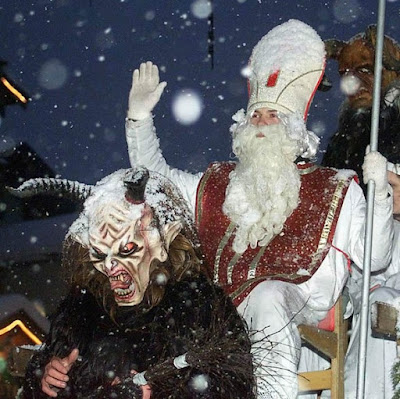Today is St. Nicholas Day so I thought I would share some of the traditions celebrated on the day around the world.
In Austria, parts of Germany, and Switzerland, der Heilige Nikolaus (or Pelznickel) brings his gifts for children on Nikolaustag, Dec. 6, not Dec. 25. Nowadays, St. Nicholas Day (der Nikolaustag) on Dec. 6 is a preliminary round for Christmas.
Nikolaustag – 6. Dezember
On the night of December 5 (in some places, the evening of Dec. 6), in small communities in Austria and the Catholic regions of Germany, a man dressed as der Heilige Nikolaus (St. Nicholas, who resembles a bishop and carries a staff) goes from house to house to bring small gifts to the children. Accompanying him are several ragged looking, devil-like Krampusse, who mildly or nor so mildly scare the children. Although Krampus/Knecht Ruprecht carries eine Rute (a switch), he usually only teases the children with it, while St. Nicholas hands out small gifts. In some regions, there are other names for both Nikolaus and Krampus (Knecht Ruprecht in northern Germany). As early as 1555, St. Nicholas brought gifts on Dec. 6, the only “Christmas” gift-giving time during the Middle Ages, and his companion, Knecht Ruprecht or Krampus, was a more ominous figure. In Alpine Europe Krampus is still a scary, devil-like figure. The Krampuslauf custom found in Austria and Bavaria also happens around December 5 or 6, but it also can take place at various times during November or December, depending on the community.
Nikolaus and his escorts don’t always make a personal appearance. In some places today, children still leave their shoes by the window or the door on the night of Dec. 5. They awaken the next day (Dec. 6) to discover small gifts and goodies stuffed into the shoes, left by St. Nicholas. This is similar to the American Santa Claus custom, although the dates are different. Also similar to American custom, the children may leave a wish list for Nikolaus to pass on to the Weihnachtsmann (Father Christmas) or the Christkind for Christmas.
Source: The German Way & More
Slovakia
The customs associated to St. Nicholas´ Day (6th December) gradually developed into the form known nowadays.
One of the customs of an ancient origin was marching of the three men in masks. The first of them represented a goat led by the second man wrapped in straw. The third man had an effigy of a woman dressed in trousers with boots hanging from them tied on his back. When the man turned round the effigy was kicking the passers-by with its boots.
Another custom became frequent later. St. Nicholas with an angel and a devil went round the houses giving out presents or the “devils reward”.
Source: Travel in Slovakia
Poland
In the past it was on the Saint Nicholas feast when the little ones received gifts, and Poles generally did not hand out presents on Christmas Eve. With time, when the Western customs of giving major gifts around Christmas started to reach Poland, it became natural that Mikołajki is just a prelude to bigger celebrations starting on December 24th. In some parts of Poland it is easier to distinguish these two gift-giving occasions, as Saint Nicholas is so tired after his special day, that he is replaced by Angel or Snowflake around Christmas Day. Nonetheless, in general most Polish children get to meet him twice a year.
Source: Careers in Poland
Holland
In countries such as Holland, you will be able to find special St Nicholas Day boots to mark the occasion. They will then hope to wake to find them filled with small presents on the day.
Apples and coins are traditionally given to children on this day too and families will celebrate with a large meal on the day itself or on the eve.
Apples and coins are traditionally given to children on this day too and families will celebrate with a large meal on the day itself or on the eve.
In some families, the father will dress up as Saint Nicholas on the eve before the special day.
Netherlands
During these parades, someone dresses up as Sinterklaas on a horse, boat, carriage, or even helicopter.
Sinterklaas travels to hospitals, schools, and from home to home, leaving small gifts for well-behaved children.
Italy
Unmarried women who have not found their perfect match also receive gifts.
They will partake in a special mass called Rito delle nubili. This is a ritual where they turn a column seven times, which is said to bring them good luck in finding a spouse.
This comes from the story where Saint Nicholas dropped a bag from the chimney into a stocking for a poor man who was unable to afford dowries for his three daughters. This ensured they could get married.
Source: Metro
France
He wears a long white beard, a miter and a crosier and a long coat, often purple (sometimes blue or red). He is accompanied by Father Flog: he is the opposite from Saint Nick. He is scary looking and distributes flogs to flog naughty children.
Source: French Today
This post is part of...










No comments:
Post a Comment
Your comments are welcome and appreciated. Blessed Be.